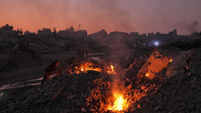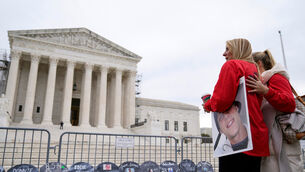Bloodbath as Mubarak supporters battle protestors
Supporters of President Hosni Mubarak charged into Cairo’s central square on horses and camels as others rained firebombs from rooftops in an apparent orchestrated assault against protesters trying to topple Egypt’s autocratic leader of 30 years.
Three people died and 600 were injured in the carnage yesterday and protesters accused Mr Mubarak’s regime of unleashing a force of paid thugs and plainclothed police to crush their unprecedented nine-day-old movement, a day after the 82-year-old president refused to step down immediately.
They showed police ID badges they said were wrested from their attackers and some government workers said their employers ordered them on to the streets.
Claims that the state may have co-ordinated violence against protesters who had kept a peaceful vigil in Tahrir Square for five days, prompted a sharp warning the US.
“If any of the violence is instigated by the government, it should stop immediately,” said White House press secretary Robert Gibbs.
The clashes marked a dangerous new phase in Egypt’s upheaval – the first significant violence between government supporters and opponents.
The crisis took a sharp turn for the worse almost immediately after Mr Mubarak rejected calls for him to give up power or leave the country, stubbornly proclaiming he would not stand down until September and die on Egyptian soil.
Mr Mubarak’s supporters took to the streets yesterday in significant numbers for the first time, some hostile to journalists and foreigners.
After midnight, 10 hours after the clashes began, the two sides were locked in a stand-off at a street corner, with the anti-Mubarak protesters behind a line of metal sheets hurling firebombs, with government backers on the rooftop above.
Soldiers surrounding Tahrir Square fired occasional shots in the air throughout the day but did not appear to otherwise intervene in the fierce clashes and no uniformed police were seen.
Most of the troops took shelter behind or inside the armoured vehicles and tanks stationed at the entrances to the square.
“Why don’t you protect us?” some protesters shouted at the soldiers, who replied they did not have orders to do so and told people to go home.
Some of the worst street battles raged near the Egyptian Museum at the edge of the square. Pro-government rioters blanketed the rooftops of nearby buildings and hurled bricks and firebombs on to the crowd below – in the process setting a tree ablaze inside the museum grounds.
Plainclothed police at the building entrances prevented anti-Mubarak protesters from storming up to stop them.
The two sides pummelled each other with chunks of concrete and bottles at each of the six entrances to the sprawling plaza, where 10,000 anti-Mubarak protesters tried to fend off more than 3,000 attackers who besieged them.
Some on the pro-government side waved machetes, while the square’s defenders filled the air with a ringing battlefield din by banging metal fences with sticks.
In one almost medieval scene, a small contingent of pro-Mubarak forces on horseback and camels rushed into the anti-government crowds, trampling several people and swinging whips and sticks. Protesters dragged some riders from their mounts, throwing them to the ground and beating their faces. The horses and camels appeared to be ones used to give tourists rides around Cairo.
Dozens of men and women with bars prised loose pieces of pavement and ferried the piles of ammunition in canvas sheets to their allies at the front. Others directed fighters to streets needing reinforcements.
The protesters used an underground station as a makeshift prison for the attackers they managed to catch. They tied the hands and legs of their prisoners and locked them inside.
Some protesters wept and prayed in the square where only a day before they had held a joyous, peaceful rally of a quarter-million, the largest demonstration so far.
Egyptian health minister Ahmed Sameh Farid said three people died and at least 611 were injured in Tahir Square. One of those killed fell from a bridge near the square. Mr Farid said the man was in civilian clothes but may have been a member of the security forces.
After years of tight state control, protesters emboldened by the uprising in Tunisia took to the streets on January 25 and mounted a once-unimaginable series of demonstrations across Egypt.
The pressure for demonstrators to clear the square mounted throughout yesterday, beginning early when a military spokesman appeared on state TV and asked them to disperse so life in Egypt could get back to normal.
Then the regime began to rally its supporters in significant numbers for the first time, demanding an end to the protest movement. Some 20,000 Mubarak supporters held an angry, but mostly peaceful rally across the Nile River from Tahrir, responding to calls on state TV.
They said Mr Mubarak’s concessions – promising not to run for re-election in September, naming a new government and appointing a vice president for the first time, widely considered his designated successor – were enough.
The anti-Mubarak movement has vowed to intensify protests to force the president out by tomorrow.













